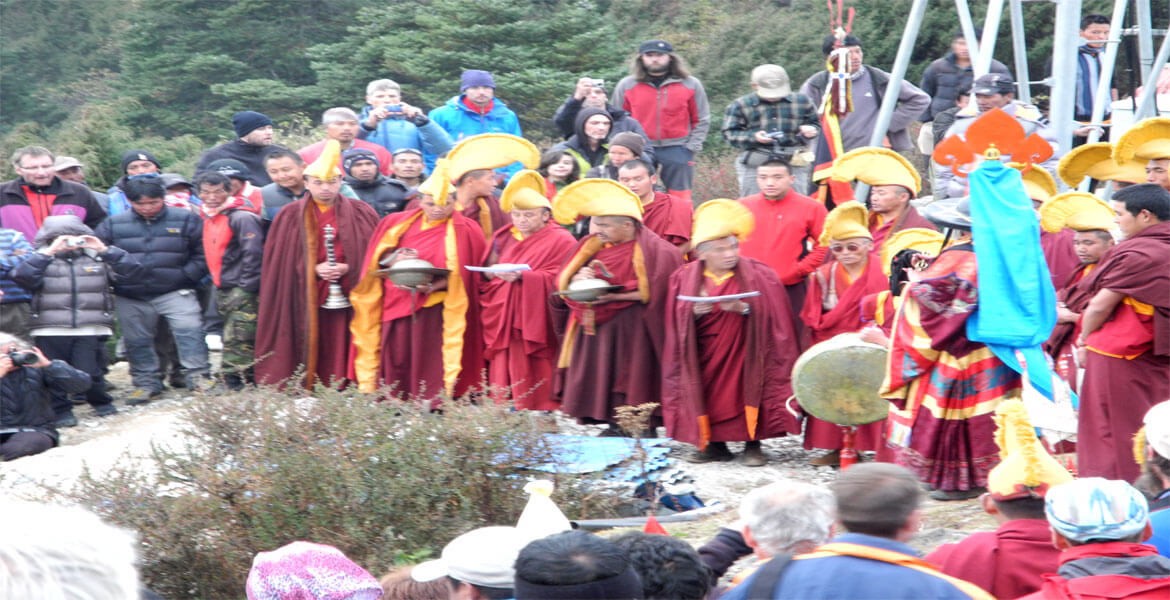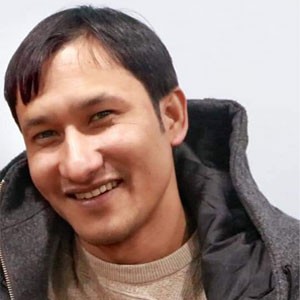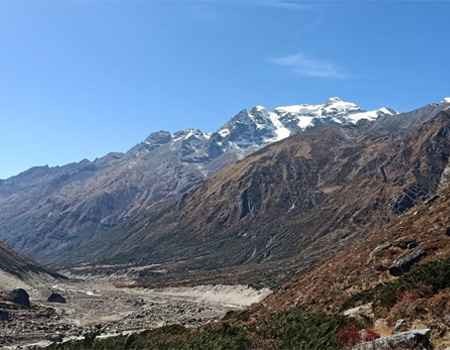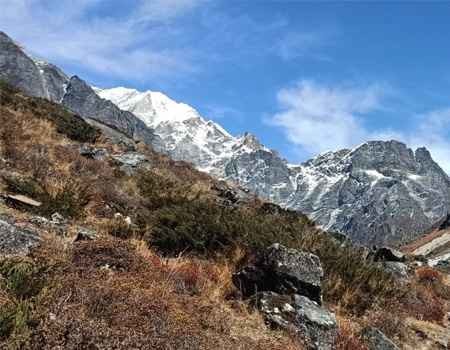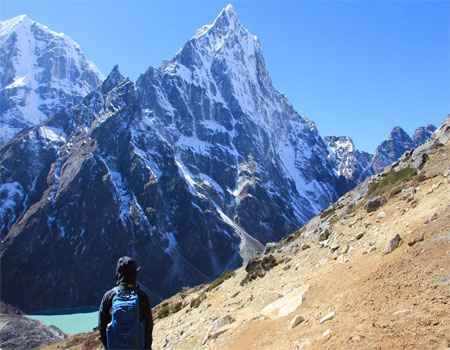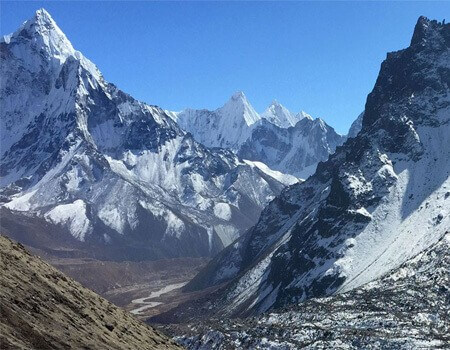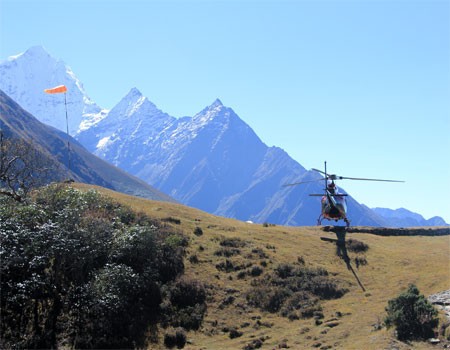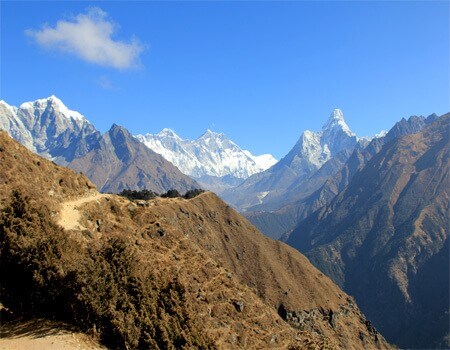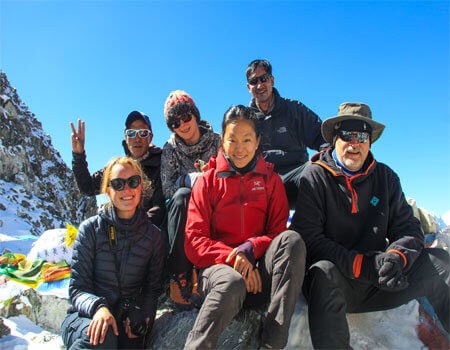Mani Rimdu is a festival of the Tibetan Buddhist Sherpa people in autumn around the Tengboche monastery in the Everest region. Local people, monks from different monasteries, and Lamas gather for five days to wish for the world's protection. The festival includes dramas, dances with masks, prayers with mantras, and feasts. In the symbolic drama of this festival, the pious defeat demons. It is an essential and colorful festival celebrated yearly in the Everest region during autumn.
When is Mani Rimdu
The Mani Rimdu date is fixed in October and November, which remains in the 10th month of the Tibetan lunar calendar. It is a 19-day festival, but the last three days are officially a celebration. The festival does not set exact dates permanently so that the dates can be fixed according to the Tibetan Lunar calendar every year.
Mani Rimdu Celebrations
Mani Rimdu is celebrated on the full moon day in the autumn months of October and November. This festival has six different celebration arrangements, which are listed below:
Sand Mandala
The sand Mandala, made step by step with colored sand, is a meditational device with symbolic designs and meanings. It takes several days to complete. Defensive blades representing deities are placed around the Mandala, and a bowl of spiritual medicine is placed above the center. This Mandala represents the palace of Garwang Thoche Chhenpo, the lord of the dance.
The Monks repeat the mantras "OM AH HUN RI" and "OM MANI PADME HUN" thousands of times during the week of the Mani Rimdu ceremony before the public festival. The Monks imagine kindness through meditation and mantras in the Mandala and the Mani Rilwu pills (spiritual medicine). Then, kindness will be released from the Mandala, and those attending the Mani Rimdu festival will be blessed.
Wong (The Empowerment)
The Wong is the opening ceremony of the Mani Rimdu. It sets up on the full moon day in October/November (according to the Tibetan lunar calendar). The Mani Rilwu (blessed pills) and T-showreel ( pills for a long life) are assigned to everyone who attends the festival.
Chham (The Dances)
The second day of the Manirimdu festival celebration will be filled with dances. Demons flunked or transformed into protectors of Dharma symbolically through the dance preference. The central theme of the dance is a positive force fighting against the evil power. This type of dance expresses Buddhist teaching philosophically. The monks believed in changing into the divine being during the dance. This type of dance is only performed during the Mani Rimdu festival because it is sacred and not for entertainment.
Ser-Kyem
Ser-Kyem is a tea-offering ceremony to Dharma guards such as Mahakala. The tea is offered in two bowls: a large dish-shaped bowl and a small offering bowl. During the Ser-Kyem offerings, the smaller bowl is clamped in the proper upper position of the giant bowl. During the non-offering time, the smaller bowl blends into the big bowl. The large dish is also used for food offerings. The six dancers represent Ngang-pa tantric magicians during spiritual nectar ceremonies.
Tibetan Buddhists offer alcohol from silver vessels and small thermoses to the Lamas, Khandro, Yidam, and the earth deities (Si-Dak). They also practice making offerings to the Lama, Dakini, and Yidam, which help with various actions leading to Buddhahood.
Jinsak Offerng (The Fire Puja)
After the dances, the fire Puja takes place in the Monastery yard. It is an offering to the fire god (Agni) and the gods of Mandala to decrease all harm and disturbance in the world. The harm is diffused through burning grain and butter into the fire.
After the fire Puja ceremony, the sand Mandala is broken into pieces and given as an offering to the serpent god Nagas.
'Chhingpa'
The next dance represents four defending the Buddhist faith against attack by demons. Shining paper masks in different colors and constant smiles cover the faces of the dancers who perform during the Mani Rimdu festival. The dancers go to the audience and try to beat children for fun.
The five priests perform the Dakini dance in slow-motion steps with perfect timing in drums and bell beats during the Mani Rimdu festival. The dancers don't wear masks in this dance but are present as female spiritual figures (the partners of Guru Rinpoche). They believe in coming from the pure land Sangdok Palri, where they live within his Mandala. They believe in the arrival of Guru Rinpoche during the Mani Rimdu festival. Two male Ghing carry windows, and two females carry drums. The men represent skillful means, and the women represent wisdom. These two aspects are made with barley flour and decorated with colorful butter called the Torma. These things are the symbols of the deities and symbolize enlightenment at the end of the ceremony. It remains in the temple in front of the scared Mandala.
Mani Rimdu Festival Trek
There are several trekking packages in the Everest region that you can do during the Mani Rimdu. Everest panorama trek is the most popular trekking package for this festival, but you can do the Everest base camp, high passes, and Cho La pass treks while you participate in Mani Rimdu.
Everest Base Camp Mani Rimdu Trek
The regular Everest Base Camp trekking Mani Rimdu itinerary is twelve days from Kathmandu to Kathmandu. Still, you need to add three more days to the regular plan for the festival. You will trek to the Tengboche monastery from Lukla after flying into the Lukla for the festival. It takes four days to reach Tengboche, including one rest day in Namche Bazaar for the altitude practice. You will trek up to the base camp after three days of celebration of the Mani Rimdu in Tengboche. Here, you can see an outline itinerary of the EBC Mani Rimdu Trek:
- Day 01: Fly from Kathmandu or Manthali to Lukla (2,840m) and trek to Phakding (2,610m)
- Day 02: Trek from Phakding to Namche Bazaar (3,440m) 7 hrs
- Day 03: Spare day at Namche and acclimatization hike to Everest View Hotel (3,880m) 4 hrs
- Day 04: Trek from Namche Bazaar to Tengboche (3,860m) 5-6 hrs (1st day Mani Rimdu celebration)
- Day 05: 2nd day of the Mani Rimdu Festival celebration
- Day 06: 3rd day of Mani Rimdu festival celebration
- Day 07: Trek from Tengboche to Dingboche (4,410m) 5-6 hrs
- Day 08: Trek from Dingboche to Lobuche (4,910m) 6 hrs
- Day 09: Trek from Lobuche to Gorakshep (5,180m) 3 hrs and hike to Everest base camp (5,364m) 3 hrs
- Day 10: Hike from Gorakshep to Kala Patthar (5,550m) 2 hrs and trek to Pheriche (4,210m) 5hrs
- Day 11: Trek from Pheriche to Namche Bazaar (3,440m) 7 hrs
- Day 12: Trek from Namche Bazaar to Lukla (2’840m) 7 hrs
- Day 13: Fly out from Lukla to Manthali or Kathmandu
Suppose you do not have enough time to complete the itinerary listed above. In that case, you can fly back on a helicopter directly from Gorakshep after visiting the Everest base camp and Kala Patthar.
Everest Panorama Mani Rimdu Trek 2023
The Everest Panorama Trek during the Mani Rimdu is the shortest trip in the Everest region. This short trip can be made in a week from Kathmandu to Kathmandu, but it may take two days more if you would like to celebrate the festival in October/November. An itinerary for the Mani Rimdu Everest Panorama Trekking has been given below:
- Day 01: Fly from Kathmandu to Lukla (2,840m) for 30 minutes and trek to Phakding (2,610m) for 3 hrs
- Day 02: Trek from Phakding to Namche Bazaar (3,440m) 7 hrs
- Day 03: Trek from Namche Bazaar to Tengboche (3,660m) 6 hrs – 1st day of festival celebration
- Day 04: 2nd day of festival celebration
- Day 05: 3rd day of festival celebration
- Day 06: Trek from Tengboche to Monjo (2,835m) 5 hrs
- Day 07: Trek from Monjo to Lukla (2,840m) 5 hrs
- Day 08: Fly out from Lukla to Kathmandu
Everest High Passes Mani Rimdu Trek
The Everest High Passes Mani Rimdu Trek is an adventure trekking package in the Everest region. After celebrating the festival, this high pass trip covers three significant hills: Kongma La, Cho La, and Renjo La. You will go for Kongma La from Chhukung to reach Lobuche and visit the Everest base camp and Kala Patthar.
Next, you go for the Cho La pass from Zong La to the Gokyo lakes, and the Renjo La pass leads to the Himalayan valley of Thame. Then, you return to the Namche Bazaar and trek to Lukla before flying back to Kathmandu. Everest High Passes Mani Rimdu trek itinerary has been given below:
- Day 01: Fly to Lukla (2,840m) in 30 minutes and trek to Phakding (2,610m) in 3 hrs
- Day 02: Trek to Namche Bazaar (3,440m) 7 hrs
- Day 03: Acclimatization day in Namche and hike to Everest View hotel (3,880m) 4 hrs
- Day 04: Trek to Tengboche (3,860m) 6 hrs – a 1st-day festival celebration
- Day 05: 2nd-day festival celebration
- Day 06: 3rd-day festival celebration
- Day 07: Trek to Dingboche (4,410m) 6 hrs
- Day 08: Trek to Chhukung (4,730m) 3 hrs
- Day 09: Trek to Lobuche (4,910m) 7-8 hrs via Kongma La pass (5,535m)
- Day 10: Trek to Gorakshep (5,180m) for 3 hrs and hike to EBC (5,364m) for 3 hrs
- Day 11: Hike to Kala Patthar (5,550m) and trek to Zongla (4,830m) 5 hrs
- Day 12: Trek to Gokyo (4,790m) via Cho La pass (5,360m) 8-9 hrs
- Day 13: Hike to Gokyo Ri (5,360m) 2 hrs and overnight at Gokyo
- Day 14: Trek to Maralung (4,210m) via Renjo La pass (5,360m) 7 hrs
- Day 15: Trek to Namche Bazaar (3,40m) via Thame Valley – 6 hrs
- Day 16: Trek to Lukla (2,840m) 7 hrs
- Day 17: Fly out to Kathmandu
EBC Gokyo Lake Mani Rimdu Trek
EBC Gokyo Lake Mani Rimdu Trek covers two different trekking routes: the Everest base camp and the Gokyo Valley treks. A famous high pass, Cho La, stands between these two trekking trails, so you must cross Cho La to complete this trek during the Mani Rimdu festival trek in the Everest region.
You trek up to the base camp and Kalapathar after participating in the festival in Tengboche. Then go for Gokyo Lakes via Cho La pass. You will cross a giant glacier before you reach Gokyo on this trip. EBC Gokyo Lake Manirimdu Trek itinerary has been given below:
- Day 01: Fly to Lukla from Kathmandu and trek to Phakding
- Day 02: Trek to Namche Bazar from Phakding
- Day 03: Acclimatization day in Namche
- Day 04: Trek to Tengboche from Namche Bazaar (1st-day festival)
- Day 05: 2nd-day festival
- Day 06: 3rd-day festival
- Day 07: Trek to Dingboche from Tengboche
- Day 08: Trek to Lobuche from Dingboche
- Day 09: Trek to Gorakshep from Lobuche and hike to Everest base camp
- Day 10: Hike to Kala Patthar and trek to Zongla from Gorakshep
- Day 11: Trek to Gokyo Valley from Zongla via Cho La pass
- Day 12: Hike to Gokyo Ri from Gokyo Valley and trek to Dole
- Day 13: Trek to Namche Bazaar from Dole
- Day 14: Trek to Lukla from Namche Bazaar
- Day 15: Fly out to Kathmandu from Lukla
Conclusion
Mani Rimdu is one of the most valuable and sacred festivals in the Everest region that the Tibetan Buddhists celebrate. According to the Tibetan Lunar calendar, it is permanently fixed in October or November. The festival celebration in Tengboche monastery is the most famous but also celebrated in the Monastery near Junbesi in the lower region.
If you want to do the Mani Rimdu Trek and participate in this festival, you must book a few months in advance because the accommodations in Tengboche might be full. Alternatively, you can stay in Deboche, about 20 minutes away from Tengboche Hill, and walk every day for the festival. You can consult us through the Contact Us section to book the festival trip.
